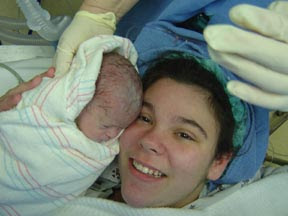Surgical removal of tonsils: tonsillectomy
Surgical removal of appendix: appendectomy
Surgical removal of breasts: mastectomy
Surgical removal of uterus: hysterectomy
Surgical removal of baby: babyectomy
Yes, a cesarean
is surgery!
Following is the actual surgical report from my cesarean. That's right, with a
cesarean "birth"... there are no "warm fuzzy" moments. It's all about "stab incisions" and organs being extracted from your body. I'm putting this here because had I known exactly what was involved in a standard surgical birth, I would have asked more questions
and made certain preferences clear. Emphasis added.
The patient
(you're not a woman, a mother, or even a human being, you are simply a "patient") was taken to the operating room where spinal anesthesia
(you know, that huge needle they stick in your spine after you sign a form saying that if you become paralyzed or die that you and your family won't sue) was introduced without complication. The patient was then prepped and draped in the usual sterile manner
(because there are TONS of nasty germs in a hospital and they're getting ready to cut you open and you wouldn't want an infection. That's why hospitals are for SICK people. Not pregnant people).The abdomen was entered via Pfannenstiel incision, which was extended to the fascia via sharp dissection
(ooo... doesn't that make you feel nice??). Hemostasis was assured via cautery. The fascia was incised and this incision extended. The remainder of the fascia was taken down in the usual manner.
The midline was identified and entered without complication. The lower uterine
segment was identified and bladder flap was created inferiorly
(Your
bladder is "in the way" so to speak, so they have to move it.
I'm sure it's impossible to get it back in the exact same position
it was in, so NEVER let a doctor tell you that a cesarean will ensure that you won't suffer from incontinence). The uterus was entered via stab incision
(don't you just picture some mad scientist stabbing you in the gut when you hear that? I know I do...), which was extended sharply. The membranes ruptured and clear fluid was noted. The head of the infant was delivered;
the nares and mouth were suctioned well, and the remainder of the
infant was delivered without complication. The infant was carried
over to the neonatologist. The placenta was manually extracted,
the uterus was delivered into the abdominal incision, and the
endometrial cavity was cleansed.
(This last sentence means
that they actually TOOK MY UTERUS OUT OF MY BODY
and plopped it up on my abdomen. That's the common thing to
do. They like to dig around inside your body and see what's
going on.)The uterine incision was then closed in two layers, first being a running
interlocking layer of #1 chromic, second being a running, imbricating
layer of the same. Hemostasis was assured via cautery as well as
suture of 2-0 chromic. When hemostasis was assured,
the uterus
was returned to the abdominal cavity. The gutters were cleansed
of clot and debris. Hemostasis was assured and the bladder flap
was reapproximated using 2-0 chromic in a running fashion.
Hemostasis was assured and the gutters again were cleansed
of clot and debris. Copious irrigation was done. Hemostasis
was assured and the peritoneum was closed using #0 chromic
in a running fashion. The subfascial layer was made hemostatic
and the fascia was reapproximated using 0 Vicryl in a running
fashion. Hemostasis was assured of the subcutaneous layer
which was reapproximated using 3-0 plain in an interrupted
fashion. Hemostasis was further assured and the skin was
reapproximated using 3-0 Vicryl in a running, subcuticular
fashion. Estimated blood loss was 600 cc.
Complications
were none.**Note: They don't consider depression, a huge gash onyour abdomen, breastfeeding failure, not being able towalk on your own or without pain, nightmares, etc to be"complications".






